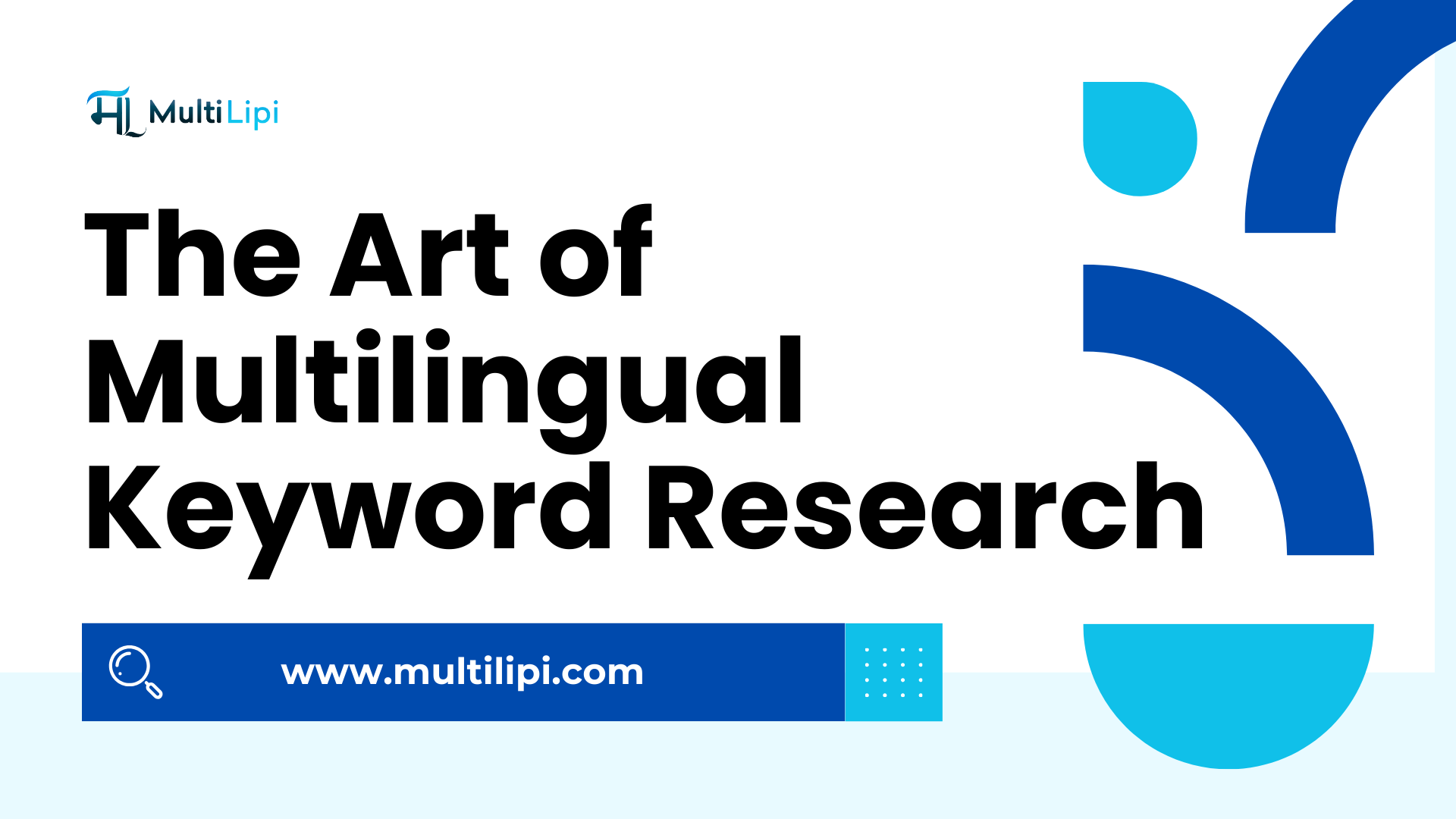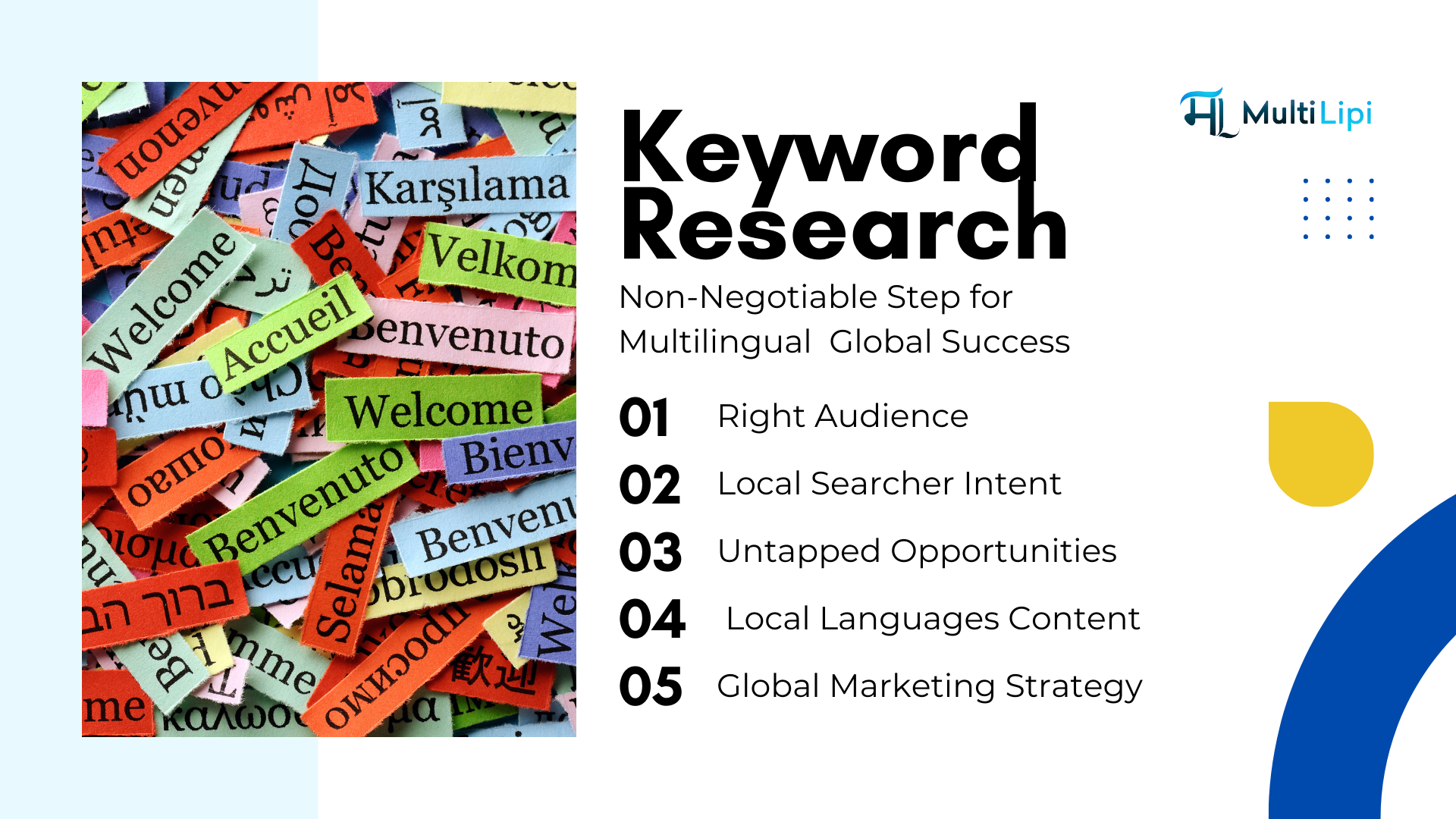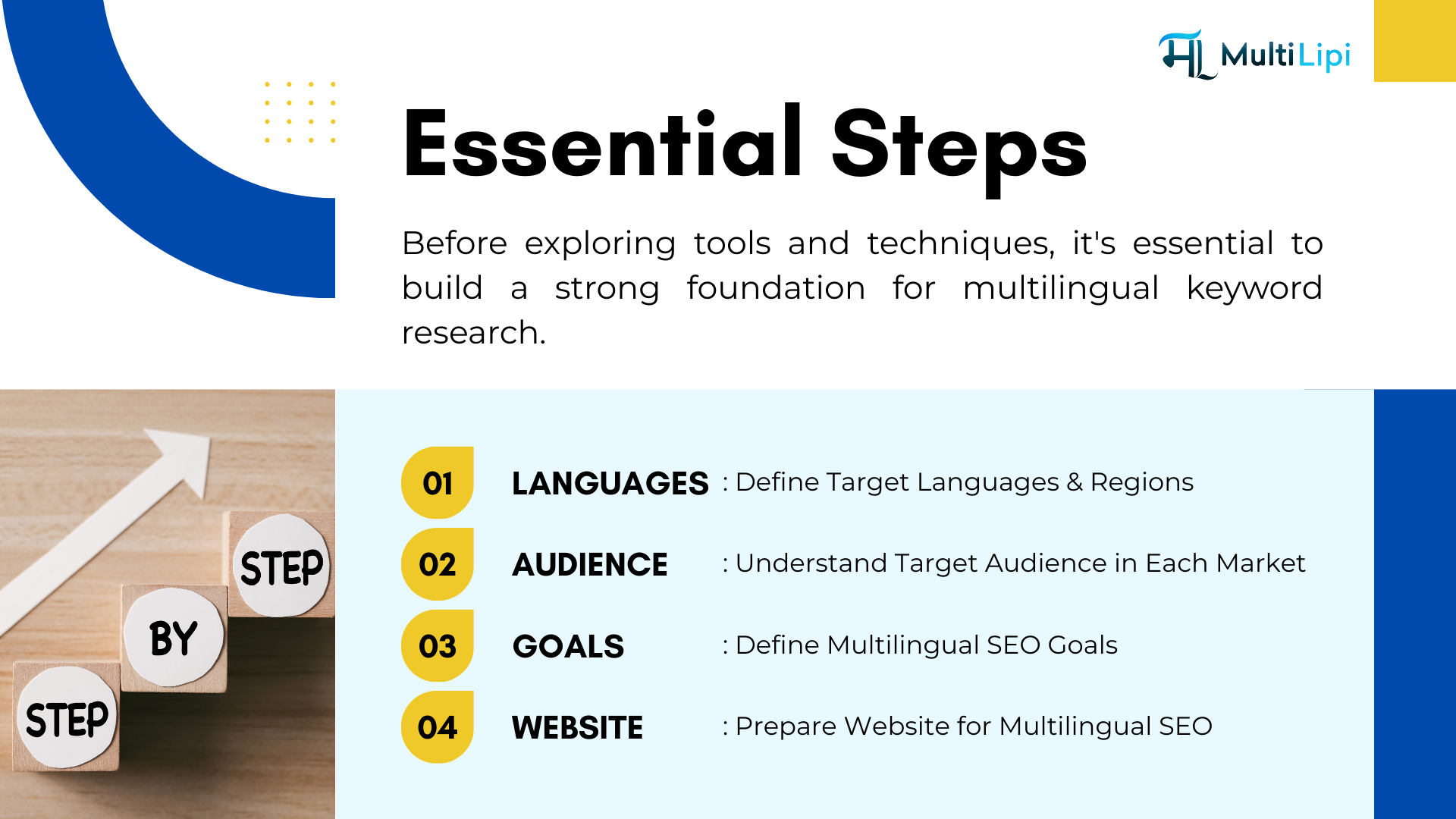The Art of Multilingual Keyword Research: A Step-by-Step Guide to Global SEO Success

Your journey to establishing a powerful multilingual online presence begins with understanding the nuances of global audiences. Our previous blogs explored the what and why behind embracing multilingualism in the digital landscape. We established that reaching diverse linguistic markets unlocks significant growth opportunities, fosters deeper customer connections, and solidifies your brand as a global authority. Now, we delve into the crucial how: mastering the art of multilingual keyword research.
Just as a compass guides a traveler, multilingual keyword research directs your content strategy, ensuring your message resonates with the right audience in their native language. This comprehensive guide, a cornerstone of our multilingual SEO services, will equip you with the tools, techniques, and understanding necessary to identify high-potential keywords across different languages and cultures, ultimately driving organic traffic, boosting conversions, and achieving true global SEO success.
Why Multilingual Keyword Research is Non-Negotiable for Global Success

Ignoring multilingual keyword research is akin to navigating a foreign city without a map or understanding the local language. You might stumble upon some success, but you'll likely miss key opportunities, frustrate potential customers, and waste valuable resources. Here's why it's a cornerstone of any successful global SEO strategy:
-
Reach the Right Audience: Translating your existing keywords directly often falls short. Search behavior and terminology vary significantly across languages and cultures. Multilingual keyword research ensures you're using the exact terms your target audience uses when searching for your products, services, or information in their native tongue.
- Understand Local Searcher Intent: The intent behind a keyword can differ dramatically across languages and regions. A keyword that signifies a transactional intent in one language might indicate informational intent in another. Understanding these nuances allows you to create content that aligns perfectly with the needs and expectations of your global audience.
- Identify Untapped Opportunities: Exploring keyword landscapes in different languages can uncover niche markets and long-tail keywords with lower competition and high relevance. These hidden gems can provide a significant competitive advantage.
- Optimize Content for Local Languages: Effective multilingual keyword research informs the creation of linguistically and culturally relevant content. This not only improves your search engine rankings but also enhances user experience, leading to higher engagement and conversion rates.
- Inform Your Overall Global Marketing Strategy: The insights gained from multilingual keyword research extend beyond SEO. They can inform your content marketing, paid advertising, and even product development strategies in different markets.
Laying the Foundation: Essential Steps Before You Begin
Before diving into specific tools and techniques, it's crucial to establish a solid foundation for your multilingual keyword research process. This involves defining your target markets, understanding your audience, and setting clear goals.

1. Define Your Target Languages and Regions
The first step is to clearly identify the languages and geographical regions you want to target. This decision should be based on a thorough analysis of your business goals, market potential, and existing customer base. For a deeper dive into this process, check out our guide on how to choose the right international markets for your business. Consider factors such as:
- Market Size and Potential: Identify markets with a significant demand for your products or services and a substantial online population.
- Existing Customer Base: Analyze where your current international customers are located and which languages they speak.
- Competition: Research the competitive landscape in different markets and identify opportunities where you can gain a foothold.
- Ease of Market Entry: Consider factors such as language complexity, cultural differences, and regulatory requirements.
- Internal Resources: Assess your team's linguistic capabilities and your budget for translation and localization efforts.
Example: If you're an e-commerce business selling hiking gear, your initial target markets might include English-speaking countries (USA, UK, Canada, Australia), German-speaking countries (Germany, Austria, Switzerland), and Spanish-speaking countries (Spain, Mexico, Argentina), based on the popularity of hiking and your shipping capabilities.
2. Understand Your Target Audience in Each Market
Once you've identified your target languages and regions, delve deeper into understanding your audience within each market. Cultural nuances, local preferences, and online behavior can significantly impact how people search for information. Consider:
- Demographics: Age, gender, income level, education, and occupation.
- Psychographics: Interests, values, lifestyles, and opinions.
- Cultural Differences: Language nuances, communication styles, social customs, and local traditions.
- Online Behavior: Preferred search engines, social media platforms, content consumption habits, and mobile usage.
- Pain Points and Needs: What problems are your target customers trying to solve, and what information are they seeking?
Tip: Conduct market research, analyze social media trends, and engage with local influencers to gain valuable insights into your target audience in each market.
3. Define Your Multilingual SEO Goals
Clearly define what you want to achieve with your multilingual SEO efforts. This will help you focus your keyword research and measure your success. Common goals include:
- Increase organic traffic from specific regions.
- Generate more leads or sales in target markets.
- Improve brand visibility and awareness globally.
- Expand into new international markets.
- Provide better customer support in local languages.
Example: Your goal for the German market might be to increase organic traffic to your hiking boot product pages by 20% within the next six months.
4. Prepare Your Website for Multilingual SEO
Before you start targeting international audiences, ensure your website is properly configured to handle multiple languages. This involves implementing the correct hreflang tags to tell search engines which language and regional variations of your pages should be displayed to users in different locations. You'll also need to decide on your website's URL structure (e.g., subdomains, subdirectories, or separate domains).
Step-by-Step Guide to Performing Multilingual Keyword Research
With a solid foundation in place, you can now embark on the core process of multilingual keyword research. This involves a combination of translation, localization, and market-specific analysis.
Step 1: Start with Your Seed Keywords
Begin by identifying your core keywords in your primary language (usually the language your business originated in). These are the broad terms that describe your products, services, or the main topics of your content.
Example (Primary Language: English): hiking boots, trekking poles, camping tents, outdoor gear, backpacking tips.
Step 2: Translate and Localize Your Seed Keywords
Simply translating your seed keywords is often insufficient. Localization goes beyond literal translation and involves adapting the language and content to the cultural nuances and local context of your target audience. This includes:
- Using native speakers: Engage professional translators or native speakers who understand the cultural nuances of the target language.
- Considering regional variations: A word or phrase can have different meanings or spellings in different regions that speak the same language (e.g., "elevator" vs. "lift" in English).
- Accounting for slang and colloquialisms: Incorporate relevant local terms that your target audience commonly uses.
Example (Target Language: German):
- Hiking boots -> Wanderschuhe (more common than "Bergstiefel" in some contexts)
- Trekking poles -> Trekkingstöcke
- Camping tents -> Campingzelte
- Outdoor gear -> Outdoor Ausrüstung
- Backpacking tips -> Tipps zum Rucksackwandern
Tool Tip: Utilize professional translation services or linguistic experts familiar with SEO best practices to ensure accurate and culturally relevant translations and localizations. Multilipi offers expert linguistic localization services tailored for SEO.
Step 3: Leverage Language-Specific Keyword Research Tools
While general keyword research tools can provide some insights, language-specific tools or features offer more accurate and relevant data for international markets. Consider the following:
- Google Keyword Planner: This free tool allows you to research keyword search volume and competition for specific languages and locations.
- Ahrefs: Offers comprehensive keyword research capabilities in multiple languages, including competitor analysis and keyword difficulty metrics.
- SEMrush: Provides robust keyword research tools with language and region-specific data, as well as features for international SEO.
- Moz Keyword Explorer: Supports keyword research in various languages and provides metrics like keyword difficulty and organic CTR.
- Ubersuggest: Offers keyword ideas and content suggestions in multiple languages.
Step 4: Analyze Competitor Keywords in Target Markets
Understanding what your competitors are ranking for in your target markets is crucial for uncovering valuable keyword opportunities.
Techniques:
- Identify local competitors: Use local search engines (e.g., Google.de for Germany, Google.es for Spain) to identify top-ranking websites in your niche.
- Use keyword research tools: Enter your competitors' URLs into tools like Ahrefs or SEMrush to see the keywords they are ranking for in specific languages and regions.
- Analyze their content: Examine their website copy, blog posts, and other content to identify the keywords they are targeting.
- Pay attention to their backlink profile: See which keywords their backlinks are anchored with.
Insight: By analyzing your competitors, you can identify keywords you might have missed and gain insights into their content strategy in different markets.
Step 5: Explore Local Search Terms and Cultural Nuances
Direct translations often fail to capture the nuances of local language and search behavior. It's essential to delve deeper into how your target audience actually searches for information.
Techniques:
- Talk to native speakers: Engage with locals or linguistic experts to understand the common terminology and phrasing used in your industry. Multilipi's network of in-country native linguists can provide invaluable insights.
- Monitor local forums and social media: Observe discussions and identify the language and keywords your target audience uses online.
- Analyze local search engine results pages (SERPs): Pay attention to the types of content that are ranking (e.g., blog posts, product pages, videos) and the language used in the titles and descriptions.
- Consider regional dialects and slang: Incorporate relevant local terms to connect with your audience on a deeper level.
- Understand local holidays and events: These can influence search trends and provide opportunities for targeted content.
Example: In the UK, someone might search for "walking boots," while in the US, "hiking boots" is more common. Understanding these regional variations is crucial for effective keyword targeting.
Step 6: Understand Searcher Intent Across Languages
The intent behind a keyword can vary significantly across languages and cultures. Understanding searcher intent (informational, navigational, transactional, or commercial investigation) is crucial for creating content that meets the needs of your audience.
Consider:
- Informational Intent: Users are looking for information or answers to questions. Keywords often include "how to," "what is," "tips for," etc.
- Navigational Intent: Users want to find a specific website or page. Keywords often include brand names or specific product/service names.
- Transactional Intent: Users are ready to make a purchase. Keywords often include "buy," "order," "price," "discount," etc.
- Commercial Investigation: Users are researching products or services before making a purchase. Keywords often include "best," "review," "compare," etc.
Example: The keyword "best hiking boots" in English likely indicates a commercial investigation intent. However, its direct translation might be used in a different context in another language. Analyze the SERPs for the translated keyword to understand the dominant intent in that market.
Step 7: Utilize Keyword Mapping for Multilingual Content
Once you've compiled a comprehensive list of keywords for each target language, the next step is keyword mapping. This involves assigning relevant keywords to specific pages on your website. This ensures that each page is optimized for the terms your target audience is most likely to use when searching for that specific content.
Process:
- Create a spreadsheet: List all your website pages and the target languages.
- Assign primary and secondary keywords: For each page and language, identify the most relevant primary keyword and several related secondary keywords.
- Consider searcher intent: Ensure the mapped keywords align with the intent of the content on each page.
- Maintain consistency: Use the mapped keywords naturally within your page titles, headings, meta descriptions, and body content.
Example: Your product page for "men's waterproof hiking boots" in English might be mapped to "wasserdichte Herren-Wanderschuhe" (waterproof men's hiking boots) in German. Secondary keywords could include "Herren Wanderschuhe wasserfest" (men's hiking boots waterproof), "beste wasserdichte Wanderschuhe Männer" (best waterproof hiking boots men), etc.
Step 8: Leverage Long-Tail Keywords in Multiple Languages
Long-tail keywords are longer, more specific keyword phrases that typically have lower search volume but higher conversion rates. They represent more specific search queries and often indicate a stronger user intent.
Example: Instead of the broad keyword "hiking boots," a long-tail keyword might be "best waterproof hiking boots for backpacking in the Rocky Mountains."
Benefits of Targeting Multilingual Long-Tail Keywords:
- Lower Competition: Less competition compared to broad, high-volume keywords.
- Higher Relevance: Matches specific user queries more closely.
- Improved Conversion Rates: Users searching with long-tail keywords often have a clearer intent to purchase or take a specific action.
- Opportunity to Answer Specific Questions: Long-tail keywords often take the form of questions, allowing you to create informative content that directly addresses user needs.
Step 9: Track and Measure Your Multilingual Keyword Performance
Once you've implemented your multilingual keyword strategy, it's crucial to track your performance and make adjustments as needed.
Key Metrics to Monitor:
- Organic Traffic: Track traffic from your target countries and languages using Google Analytics.
- Keyword Rankings: Monitor your website's ranking for your target keywords in different search engines and locations.
- Search Console Performance: Analyze impressions, clicks, and click-through rates for your target keywords in Google Search Console.
- Conversion Rates: Track how your multilingual organic traffic is converting into leads, sales, or other desired outcomes.
- Bounce Rate and Time on Page: These metrics can indicate the relevance and engagement of your content for different language audiences.
Tools for Tracking:
- Google Analytics: Essential for tracking website traffic and user behavior by language and location.
- Google Search Console: Provides insights into your website's performance in Google search results for different regions.
- Rank Tracking Tools (e.g., SEMrush, Ahrefs, Moz): Allow you to monitor your keyword rankings in specific countries and languages.
Regular Analysis: Regularly review your performance data to identify:
- Keywords that are driving the most traffic and conversions in each language.
- Keywords where you are ranking well but have low click-through rates (indicating a need to optimize meta descriptions and titles).
- Keywords where you are not ranking well and need to improve your content or build more relevant backlinks.
- New keyword opportunities that you may have missed.
Step 10: Adapt and Iterate Your Strategy
The digital landscape is constantly evolving, and so are search algorithms and user behavior. Your multilingual keyword research strategy should not be a one-time effort but an ongoing process of adaptation and iteration.
- Stay updated on search engine algorithm changes in different regions.
- Monitor competitor activities and adapt your strategy accordingly.
- Continuously research new keyword opportunities based on emerging trends and user behavior in your target markets.
- Refine your keyword mapping and content strategy based on performance data.
- Seek feedback from your international customers to better understand their needs and language preferences.
Essential Tools for Multilingual Keyword Research
Here's a summary of essential tools that will aid you in your multilingual keyword research journey:
- Google Keyword Planner: For basic keyword research, search volume data, and competition analysis in multiple languages.
- MultiLipi’s Professional Translation and Localization Services: Essential for accurate and culturally relevant language adaptation. Multilipi provides end-to-end professional translation and localization services to ensure your content is perfectly tuned for every market.
- Ahrefs: Comprehensive SEO tool with robust multilingual keyword research features, competitor analysis, and backlink analysis.
- SEMrush: Offers a wide range of SEO and competitive analysis tools, including detailed keyword research for international markets.
- Moz Keyword Explorer: Provides keyword suggestions, difficulty scores, and organic CTR data for various languages.
- Google Translate or DeepL: Useful for initial translations, but always have them reviewed by native speakers.
Best Practices for Effective Multilingual Keyword Research
To maximize the effectiveness of your multilingual keyword research efforts, keep the following best practices in mind:
- Prioritize quality over quantity: Focus on identifying high-potential, relevant keywords rather than accumulating a large list of low-value terms.
- Think like a local: Immerse yourself in the language and culture of your target audience to understand their search behavior.
- Combine different research methods: Utilize a variety of tools and techniques to gain a comprehensive understanding of the keyword landscape.
- Don't rely solely on exact match translations: Explore related terms, synonyms, and local variations.
- Pay attention to searcher intent: Create content that aligns with the needs and expectations of users searching with specific keywords in each language.
- Organize your findings: Use spreadsheets or keyword management tools to keep track of your research.
- Collaborate with native speakers and linguistic experts: Their insights are invaluable for accurate and culturally relevant keyword identification.
- Stay informed about local search engine trends and updates.
- Continuously test and refine your strategy based on performance data.
Avoiding Common Pitfalls in Multilingual Keyword Research
Several common mistakes can hinder the success of your multilingual keyword research efforts. Be sure to avoid these pitfalls:
- Relying solely on literal translations: This often leads to unnatural-sounding keywords that your target audience doesn't use.
- Ignoring cultural nuances: Failing to consider cultural differences can result in using inappropriate or irrelevant keywords.
- Using only one keyword research tool: Different tools provide different data and insights. Utilize a variety of tools for a comprehensive view.
- Focusing only on high-volume keywords: Don't overlook the potential of long-tail keywords and niche terms.
- Neglecting searcher intent: Creating content that doesn't align with user intent will result in low engagement and poor rankings.
- Not localizing content beyond translation: Ensure your content resonates culturally with your target audience.
- Failing to track and measure performance: Without data, you won't know what's working and what needs improvement.
Conclusion: Embracing the Global Search Landscape
Multilingual keyword research is not merely a task; it's an ongoing strategic endeavor that forms the bedrock of your global SEO success. By understanding the nuances of different languages and cultures, leveraging the right tools and techniques, and continuously adapting your strategy, you can effectively connect with your target audience in their native language, drive significant organic traffic, and achieve your international business goals.
Embrace the art of multilingual keyword research, and unlock the vast potential of the global search landscape. Multilipi is here to support your journey with expert linguistic services and guidance, as demonstrated in our client success stories. Contact us today to learn how we can help you conquer the world, one keyword at a time.
Remember, your global audience is waiting to be discovered. Equip yourself with the knowledge and tools outlined in this guide, and embark on a successful multilingual SEO journey.
Start your multilingual journey here.


Comments